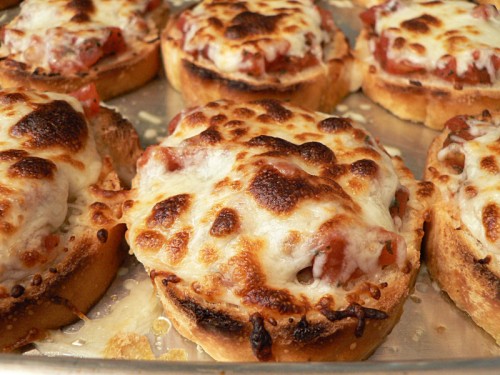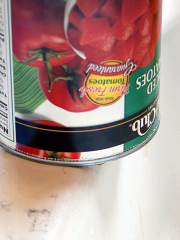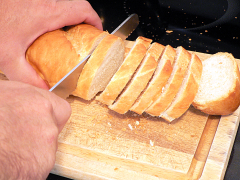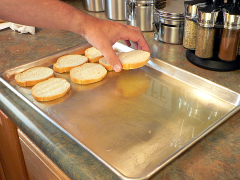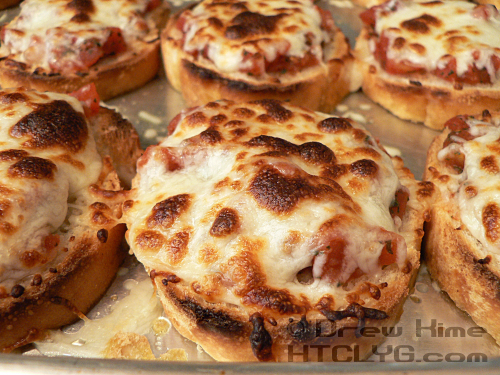Look! Out on the buffet table … it’s bruschetta … it’s French bread pizza … it’s … bruschetta pizza!
Okay, I couldn’t decide which one to call it, so it’s both.
Ingredients
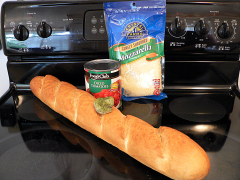
1 large can (28 ounce) diced tomatoes
1/2 loaf French bread
2 tablespoons basil pesto
8 ounces shredded mozzarella
olive pomace oil
Directions
Prep
If you’ve got fresh pesto, fabulous. What I’ve got is the stuff I made last summer and froze. So I took it out early and let it thaw. Putting it in a metal bowl will make it thaw faster. If you care about the reason why, talk to your local computer geek or car nut about radiators.[1]
So anyway … here’s the thawed pesto.
Open the tomatoes, but leave the lid attached a little bit. You don’t want all the extra juice, as it will make the bread soggy, so pour it out.
Then set the can, with the lid still on, upside-down in the sink to drain while you work on the bread.
Slice half the loaf about a half-inch thick. Don’t slice on an angle. You want each piece to be as small as possible, and cutting on a angle makes them bigger.
Appetizers are frequently made to take to someone else’s house. Since that’s what I was doing, I’ve got some tips for traveling. First is to do the prep at home and final assembly at the event. So the bread needed to go back into the paper bag it came in.
Quickest way is to stand the whole loaf up on end, with the sliced end up.
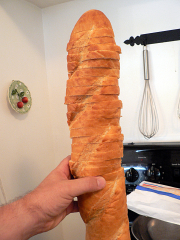 (Sometimes a loaf of bread is just a loaf of bread.)
(Sometimes a loaf of bread is just a loaf of bread.)
Then carefully slide the bag down over it.
(Hey! You there in the back row … stop giggling. What? No I don’t think it looks like I’m … Oh, uhh, yeah, I guess it sort of does. Oops.)
By now the excess juice should have drained from the tomatoes. Dump them out on a cutting board and, if they’re diced too coarsely, run a knife through them. (What’s too coarse? You don’t want it like pickle relish, but not much bigger.)
Add the drained, diced tomatoes to the thawed pesto and mix well.
Now that the tomato is ready, pack it up for the trip to the party. (Again, feel free to skip this step if you’re making it for yourself.)
Assembly
Put a few tablespoons of oil in a baking sheet and distribute it evenly.
Place the sliced bread in straight rows. No, not because it looks cool. (Though it does look cool.) You can usually pack the pan tighter that way.
Top each piece of bread with some of the tomato/basil mixture.
You could stop here and call it bruschetta. But this time, we’re adding cheese.
Put the pan under the broiler for a minute or two — keep a close eye on it — until the cheese just starts turning brown. If you’re lucky, and your broiler is very even, most of them will be finished at the same time.
Yep, that looks good.
That looks really good.
I’d like to tell you how good they tasted, but I didn’t get one. I plated them up, turned around to wash the baking sheet, and they were gone. I didn’t even get to take any pictures of them on the serving dish.
So … I guess that’s it.
1) Fine, I’ll explain. The metal conducts heat and cold (which is the absence of heat, don’t nitpick my physics) very effectively. And the thinness of the bowl presents a lot of surface area for its weight, meaning it transfers the heat (and cold) into (and out of) the air also very effectively.
Now please don’t make me explain any more science. It makes me want to create visual aids. And I don’t have time for that.
Sign up using the form to the right to get a great summer dessert recipe right in your inbox, coming up tomorrow.
By the way, here I am making this on That’s Life with Robin Swoboda.
